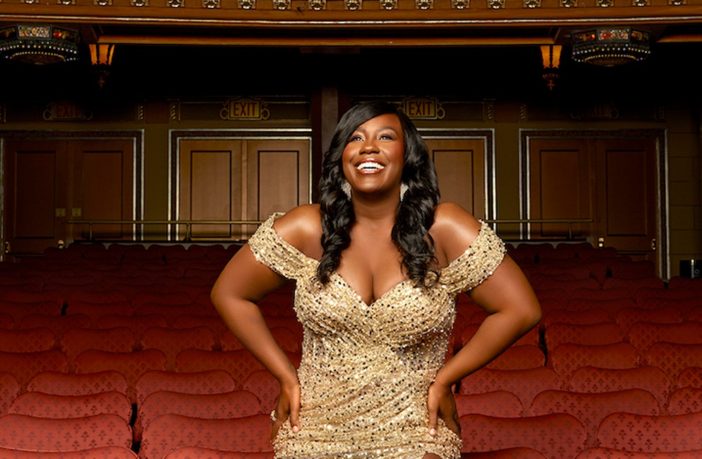With her first Tony nomination for Best Performance by a Featured Actress in a Play for the six roles she embodied in Lee Daniels’ Ain’t No Mo’, Crystal Lucas-Perry is enjoying her third win of the Broadway season. “It’s been a series of firsts for me starting with my Broadway debut as John Adams in 1776, premiering in the critically acclaimed Broadway play Ain’t No Mo’ as Passenger 5 and now, receiving a Tony nomination,” the actress declares to EBONY. “To have so many dreams manifest at once is incredibly humbling and I am honored.”
Her dizzying and electrifying delivery of Black, the spirit of Blackness chained in the basement, and of Blue, an incarcerated woman about to be released from jail, in Ain’t No Mo, deftly showcased the actress’ range. “I had the privilege and pleasure to uplift their voices and share their stories,” she shares. “My job as an actor is to serve the narrative and to elevate the text as best I can.”
While Ain’t No Mo’ had a short stint on Broadway, “This is a play written from the Black experience and is meant to be experienced by everyone,” Lucas-Perry exclaims, as she offers more on why her roles have such a big impact.
EBONY: Ain’t No Mo’ is one of the most Tony-nominated plays this season with 6 nods.
Crystal Lucas-Perry: Yes, so there is a lot to celebrate. I am so proud of my Ain’t No Mo’ family and all of what we have accomplished.
From right: Crystal Lucas-Perry and Ebony Marshall-Oliver in Ain’t No Mo’. Image: Joan Marcus.
Who else did you play in the production and which part has been the one that means the most to your heart?
My role as Passenger 5 covers four more characters: Church Lady, an organ-playing elderly woman in mourning; Newswoman, an on-the-scene news reporter; Karen, a British baby mama from the southside; and Latoya, a domestic worker for an affluent Black family. While I feel a strong connection to all of these characters, Blue holds my heart. When it is her time to be released from prison, she grapples with the reality that she is leaving with far less than when she entered. She demands that she be given back all of her belongings: her time, her peace, her smile, her dignity and her joy. When she steps over the prison threshold and back into society, we see a moment of courage as she decides to let go of her pain and start anew.
How did you prepare for these parts, which are mentally and psychically demanding?
My character track is a series of physical, technical and vulnerable choices which escalate as the play unfolds. It calls for an immense amount of stamina, precision, comedic timing and technique. It requires an actor who can seamlessly transition and convincingly embody 6 separate storylines in 95 minutes. And most importantly, it demands an equally talented and dynamic cast of storytellers: my costars Fedna Jaquet, Ebony Marshall Oliver, Marchánt Davis and Shannon Matesky to carry, balance and support the load of this massive play. When all of these elements are in alignment, I can do what I do. My cast holds me up so I can throw down. I get to be completely free on that stage and I think that audiences can feel that.
This is actually the second time you’ve been nominated for this featured role, and you won!
It’s a powerful role in a powerful play that requires a powerful actress. That’s me. And yes, I was first recognized for this role during our Off-Broadway production at the Public Theatre, where I won the Lucille Lortel Award for Best-Featured Actress in a Play. My genius playwright and castmate, fellow Tony nominee Jordan E. Cooper, created a timeless masterpiece with Ain’t No Mo’. It’s an artist’s playground for truth-telling.
The minute I read this play in 2018, I recognized its potential to change the way we experience theater. So for my audition, I held nothing back. The character choices I made in that audition room, many of which people saw on Broadway, were born from a genuine connection to the material. It’s as if Jordan left these breadcrumbs in the script, and I was on a mission to eat them all up. During our off-Broadway rehearsal process, my brilliant director, Tony nominee Stevie Walker-Webb, and I investigated how deep we could go. The play already takes you on an emotional roller coaster, and we wanted to match that energy. Let’s just say, I understood the assignment.
Ain’t No Mo’ didn’t last long on Broadway, but it made an impact. Where do you think the show can find its core audience?
Our initial PR and marketing efforts followed the traditional Broadway playbook, which did not include core demographics represented in the storytelling. The show found its base; it just needed more time to continue introducing the art to the expanded, diverse, multigenerational and multicultural audiences that the content was written to serve. Broadway historically has marketed to very specific targets and demographics. Ain’t No Mo’ transformed Broadway with its grassroots, nontraditional marketing and PR efforts ignited by our playwright, cast and producers in an effort to raise visibility and extend the run and reach of our show. Moving forward, I hope that Ain’t No Mo’ will change the way productions are marketed so that they invite the ever-evolving mosaic of culture that has an interest in Broadway. This is the recalibration that must take place on Broadway for it to continue to survive and thrive for all.



